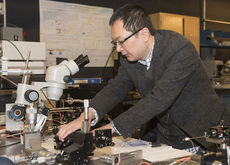
Clemson University
John Ballato, center, is complementing Lin Zhu's work, creating a high-energy laser that could be used as a weapon.

Clemson University
Lin Zhu is working on diodes that convert electricity to light.
Clemson University
The rebels and the empire used laser cannons to shoot it out on the big screen in “Star Wars,” but the weapons could soon move to the battlefield with the help of two Clemson University engineers who are receiving a combined $3.2 million from the Department of Defense.
John Ballato and Lin Zhu are taking two different but complementary approaches to creating a high-energy laser that could be used as a weapon.
Both are grappling with the odd things that happen to light at extremely high intensity and are among the challenges that must be overcome before more lasers join the fight. The military has already deployed some lasers as defensive weapons to shoot down incoming missiles and drones.
Ballato and Zhu’s work is the latest example of how Clemson researchers have carved out a niche in laser-weapon research. Since 2011, five have received a total of nearly $16 million from the Department of Defense High-Energy Laser Joint Technology Office.
In the latest round of funding, Ballato’s focus is on the optical fiber that channels the light. His challenge is to figure out what materials should be used to make the optical fiber so that they do not decrease the laser’s power.
Zhu is working on diodes that convert electricity to light. The main challenge for him is engineering a highly powerful light beam that also goes in one direction, a difficult combination.
Much of the laser research is based out of what is commonly called COMSET, which stands for the Center for Optical Materials Science and Engineering Technologies.
“They have done a spectacular job in adding to Clemson’s already stellar reputation in defense research, especially as it relates to lasers,” Stephen Foulger, COMSET’s director, said. “Their awards are well-deserved and a testament to the strength of their research and the COMSET program.”
Ballato, the former COMSET director, said that Clemson’s edge in laser research can be traced back to the late 1990s.
At the time, all the optical-fiber research was primarily focused on telecommunication. It was the early boom days of the Internet, and optical fiber is what carries Internet traffic.
Ballato and other Clemson researchers looked for an under-served market and found one in the Department of Defense.
“Time and again we’ve listened to what they needed,” he said. “We’ve written proposals specifically targeting new ideas around what they need. The testament is in the funding. We’ve delivered on those problems. We just keep on doing it.”
Clemson has maintained its relationship with the military through two wars, while building up research infrastructure and expertise. COMSET now has the only industry-grade optical fiber capability at a U.S. university.
The university’s facilities include a two-story draw tower that allows researchers to create industry-grade optical fiber. A team of researchers complements each other by focusing on different parts of a laser.
Ballato is the J. E. Sirrine Textile Foundation Endowed Chair of Optical Fibers and has received $1.8 million in his latest round of funding. Zhu is an associate professor of electrical and computer engineering and has received $1.4 million.
Both have options to extend their research if the Defense Department likes the results.
Other Clemson researchers to receive money from the High-Energy Laser Joint Technology Office includeLiang Dong, associate professor ofelectrical and computer engineering, andEric Johnson, PalmettoNet Endowed Chair in Optoelectronics.Joe Kolis, a professor of inorganicchemistry, has been a key collaborator on laser-focused research.
“The awards are a testament to their creativity and the strong rapport each has built with the Department of Defense over a number of years,” Anand Gramopadhye, dean of theCollege of Engineering, Computing and Applied Sciences, said.
“Further, the awards underscore that COMSET is the premier academic resource for optical materials research. I congratulate the team on making COMSET a world-class center with the highest standard of excellence,” Gramopadhye said.